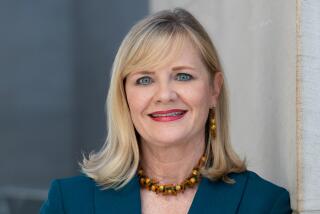Morr Returns to Arts Center in New Job
COSTA MESA — Judith O’Dea Morr has been appointed director of programming, a new position, at the Orange County Performing Arts Center. Her salary has not been disclosed.
Morr was the center’s general manager until she resigned the post in 1993 in tandem with the retirement of her husband, former center president and executive director Thomas R. Kendrick, who remains on the board of directors. Morr and Kendrick both have stayed on as paid consultants.
Center president Tom Tomlinson said in a press release that Morr, whose duties begin immediately, will work with him “on all programming areas: booking attractions, budgeting and other areas of the day-to-day programming operation.”
However, Morr will concentrate on “center-presented events” only, according to a center spokesman who said executive vice president Philip Mosbo “will continue to deal with the resident companies.” The center books touring Broadway musicals, ballet companies and some other programs; the building also is used by several regional organizations, principally the Pacific Symphony, the Philharmonic Society of Orange County and Opera Pacific, which book and produce their own attractions.
Tomlinson, who was brought in to replace Kendrick with Kendrick’s strong recommendation, said he needs Morr so he can focus more effectively on strategic planning, fund-raising and board development.
The center is studying a prospective expansion, to include a second hall. It now has one main venue, 3,000-seat Segerstrom Hall. An update on expansion plans from a board-appointed planning committee was to have been presented Thursday at a regular board meeting but was dropped from the agenda. Center officials say it needs further study and won’t be presented for several months.
Tomlinson has said that unless the center expands, it will become less competitive with centers built recently in Cerritos and Escondido and with others in Los Angeles and Palm Beach.
In a presentation to the board Jan. 24, Tomlinson said Segerstrom Hall is overbooked--it is operating at 160% of capacity by arts-industry standards, he said--and may see a decline in its regional market share of the performing arts audience.
The center, which operates on a roughly $20-million annual budget, is a not-for-profit corporation; its income must be subsidized by private contributions of roughly $5 million a year. Unless it retains its market share, Tomlinson said, the gap between earned income and overall expenditures is likely to increase, requiring greater contributions from already hard-pressed corporate and private donors.
More to Read
The biggest entertainment stories
Get our big stories about Hollywood, film, television, music, arts, culture and more right in your inbox as soon as they publish.
You may occasionally receive promotional content from the Los Angeles Times.










